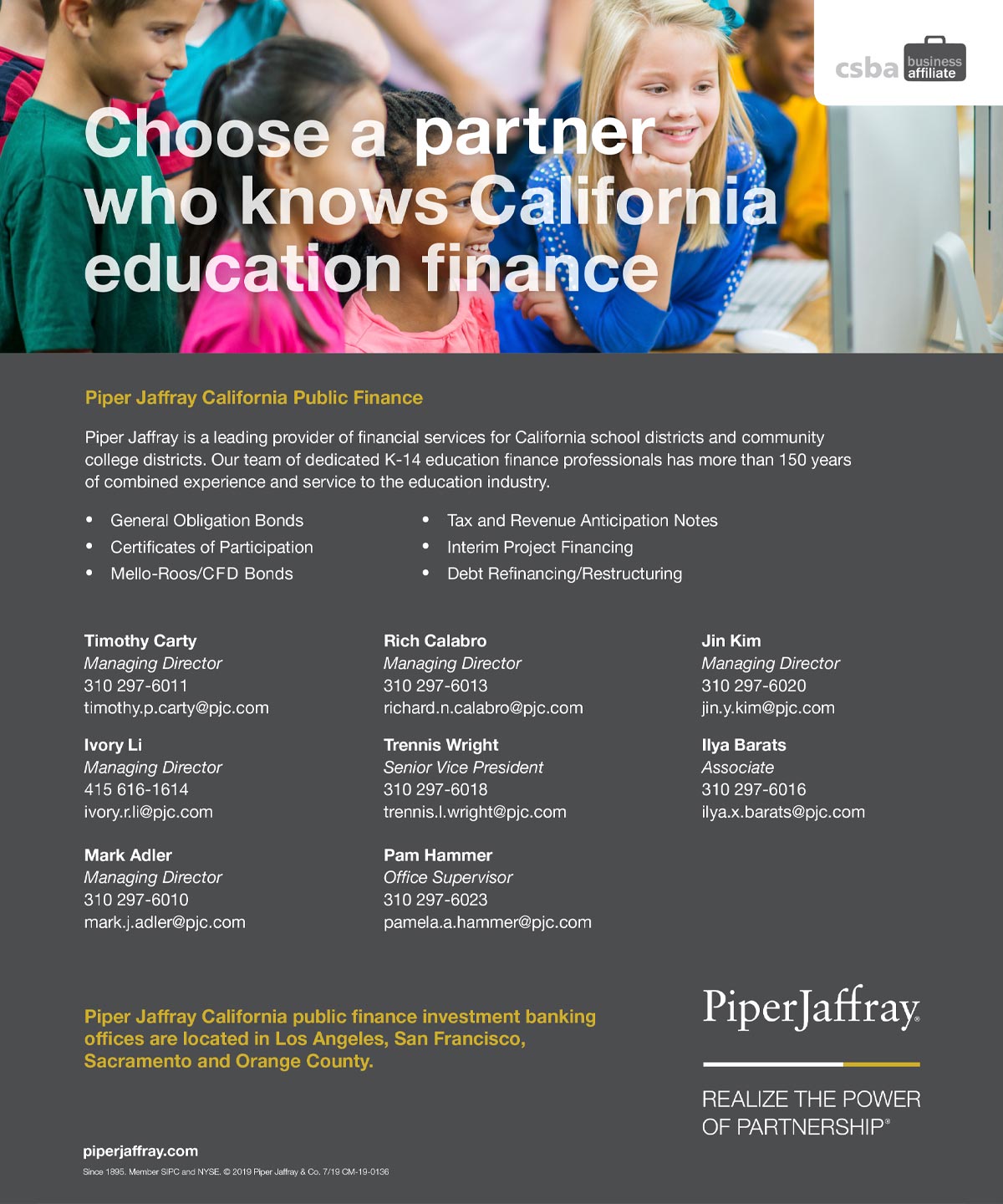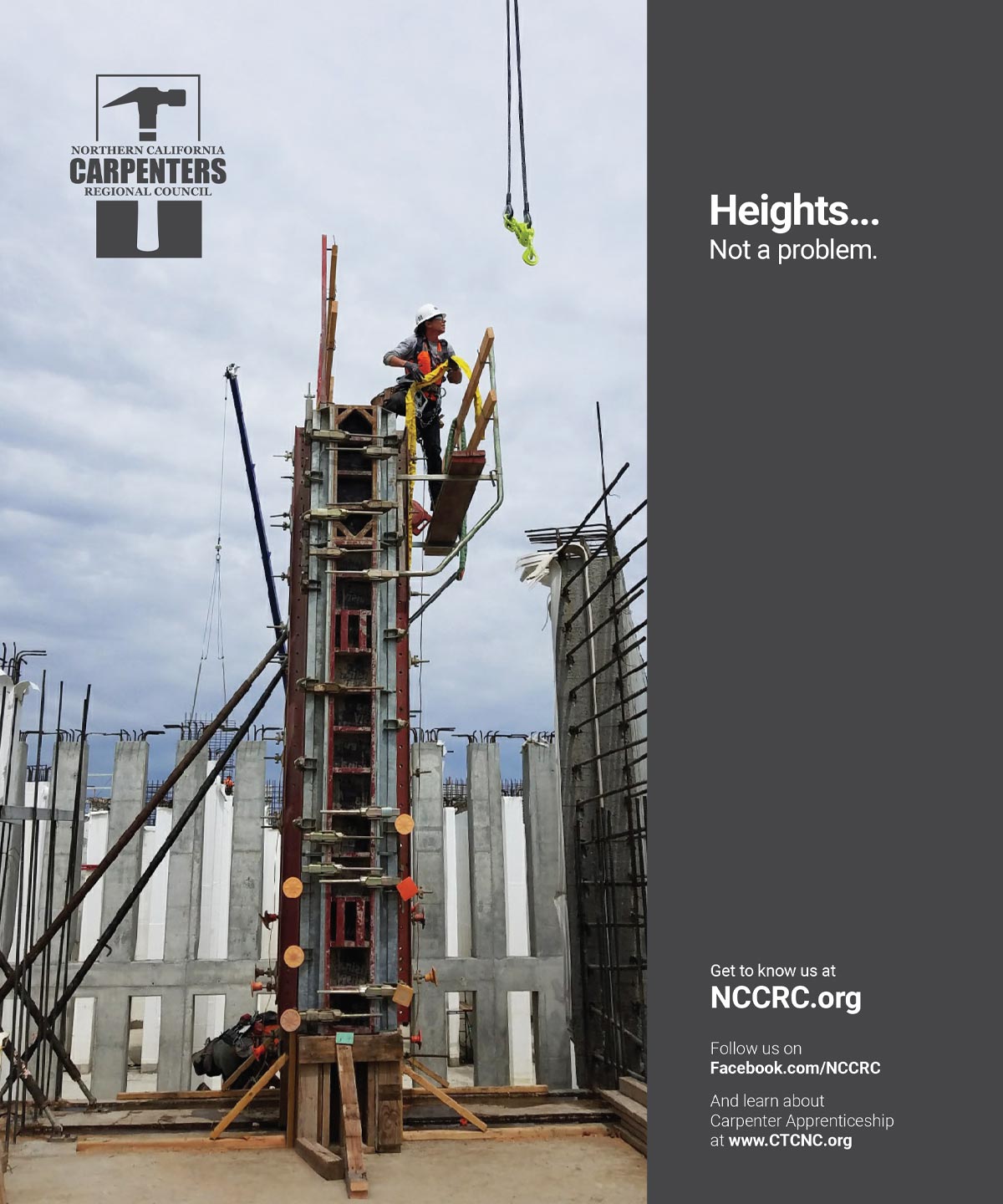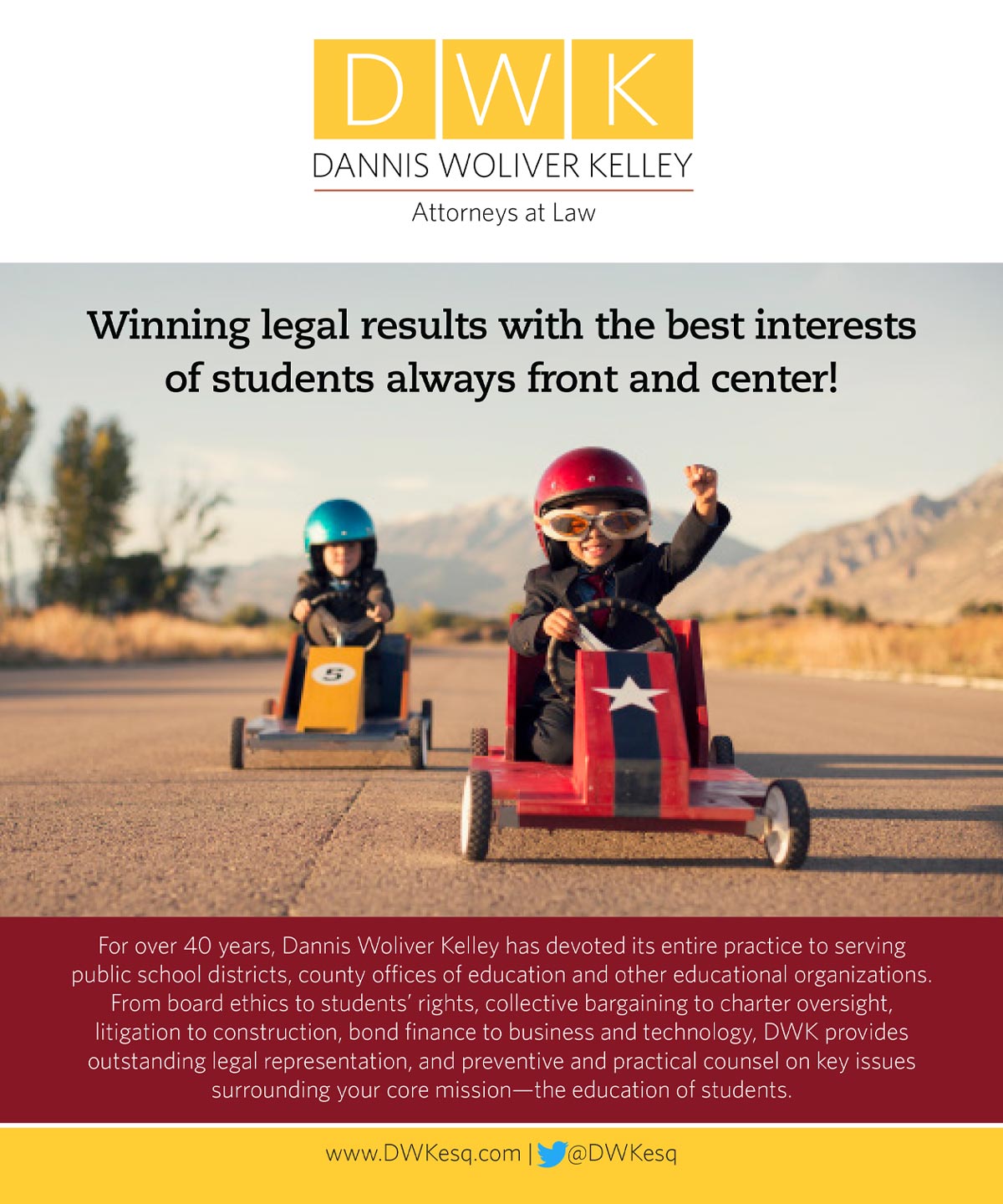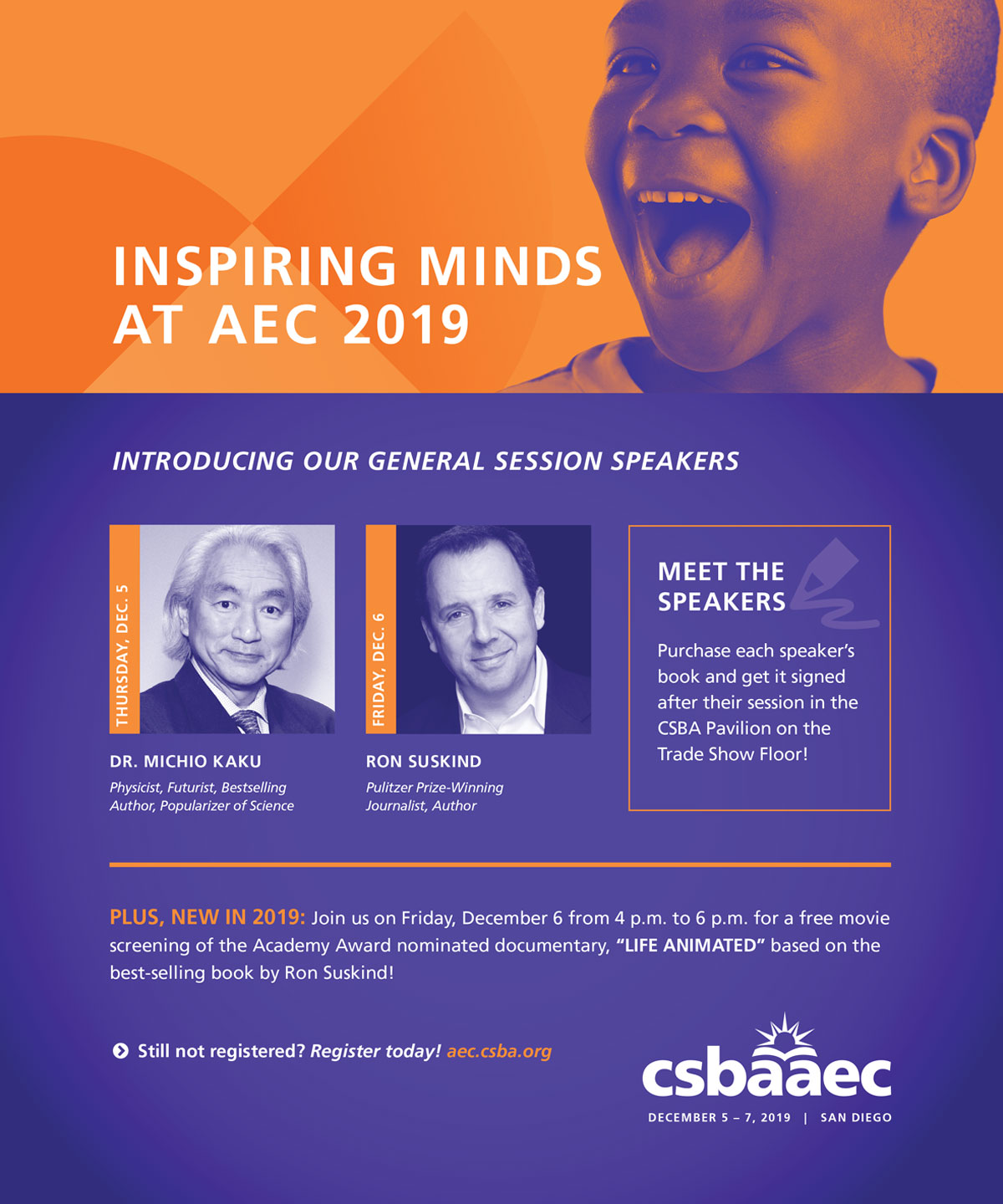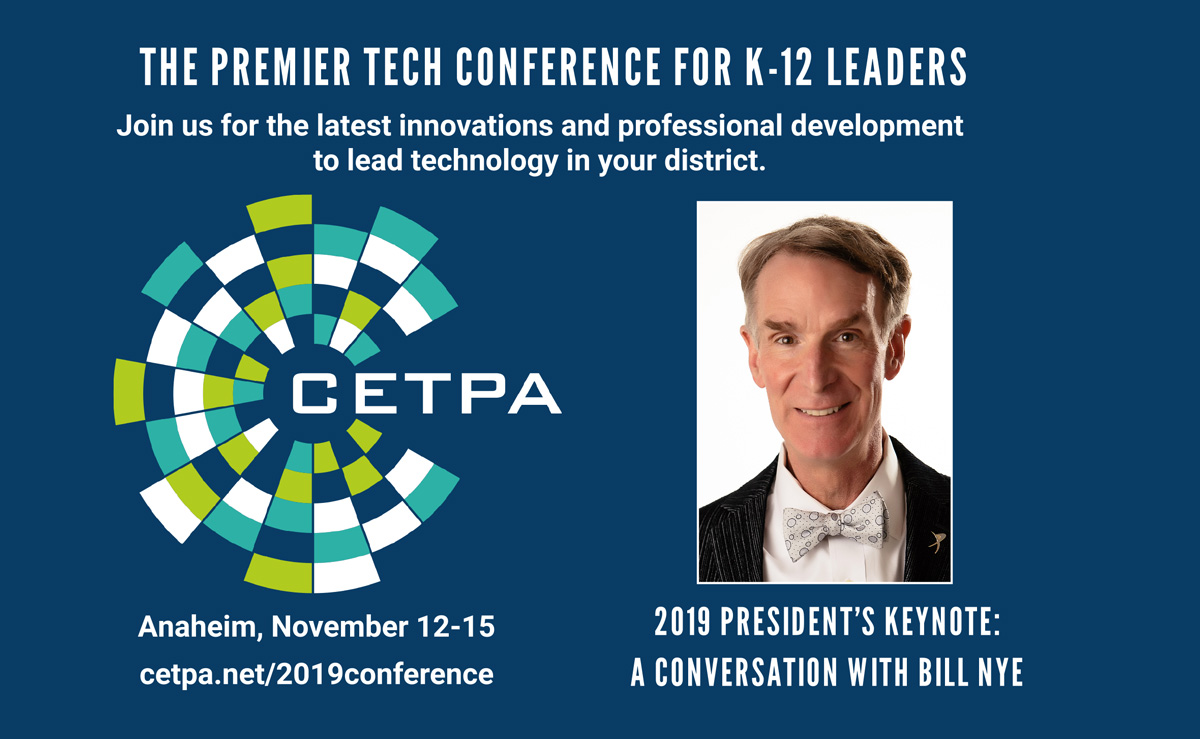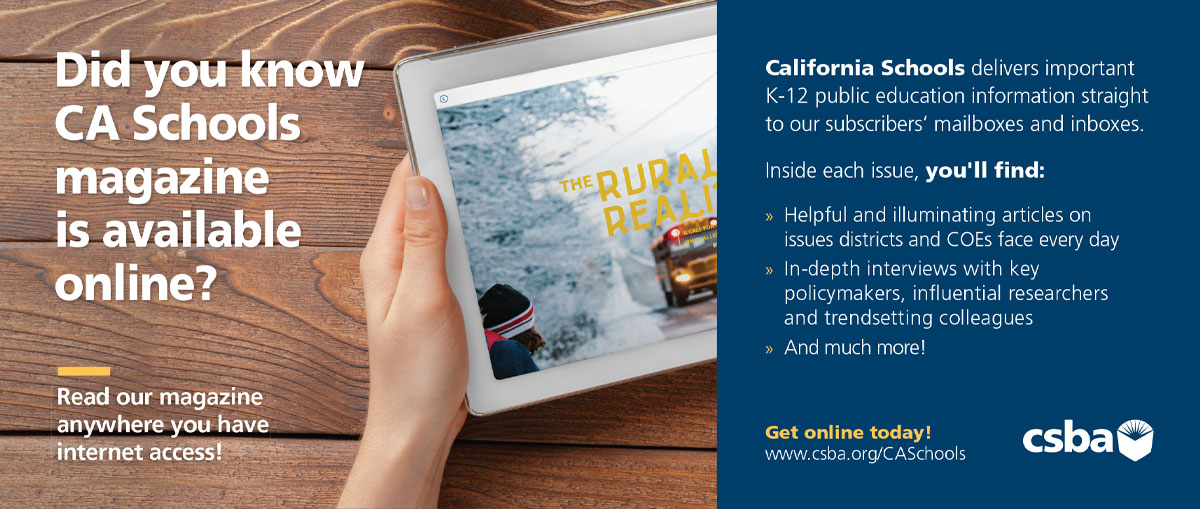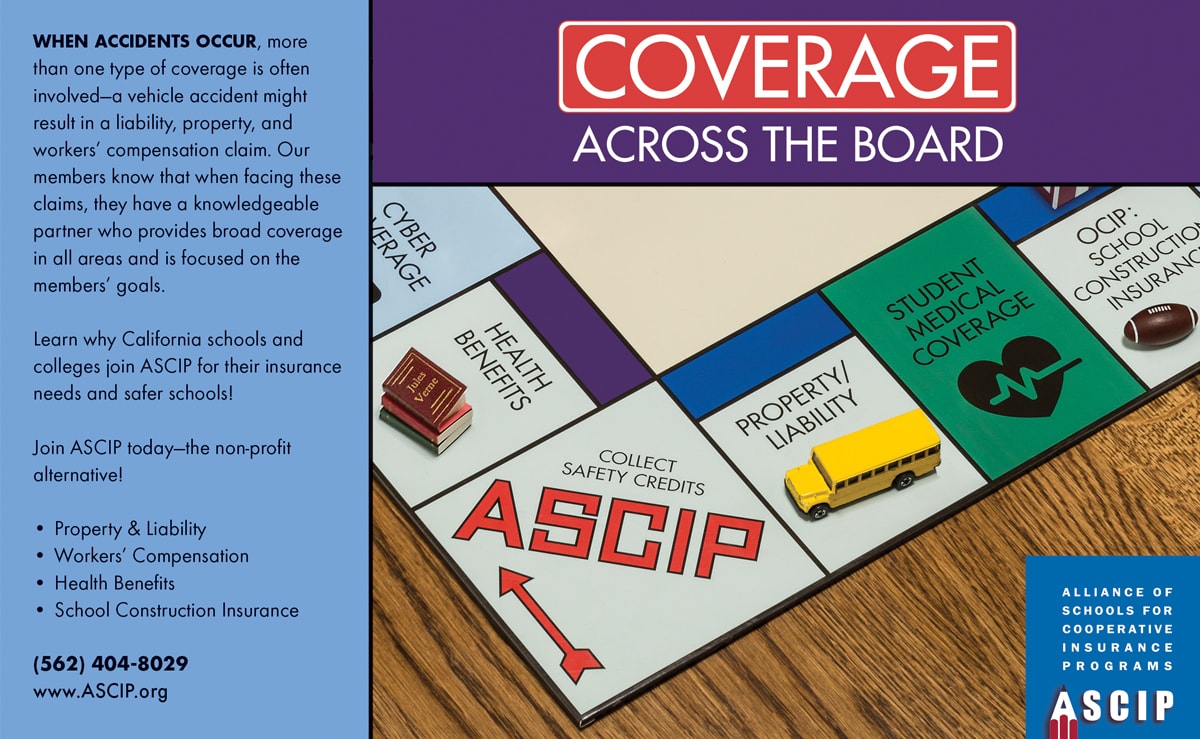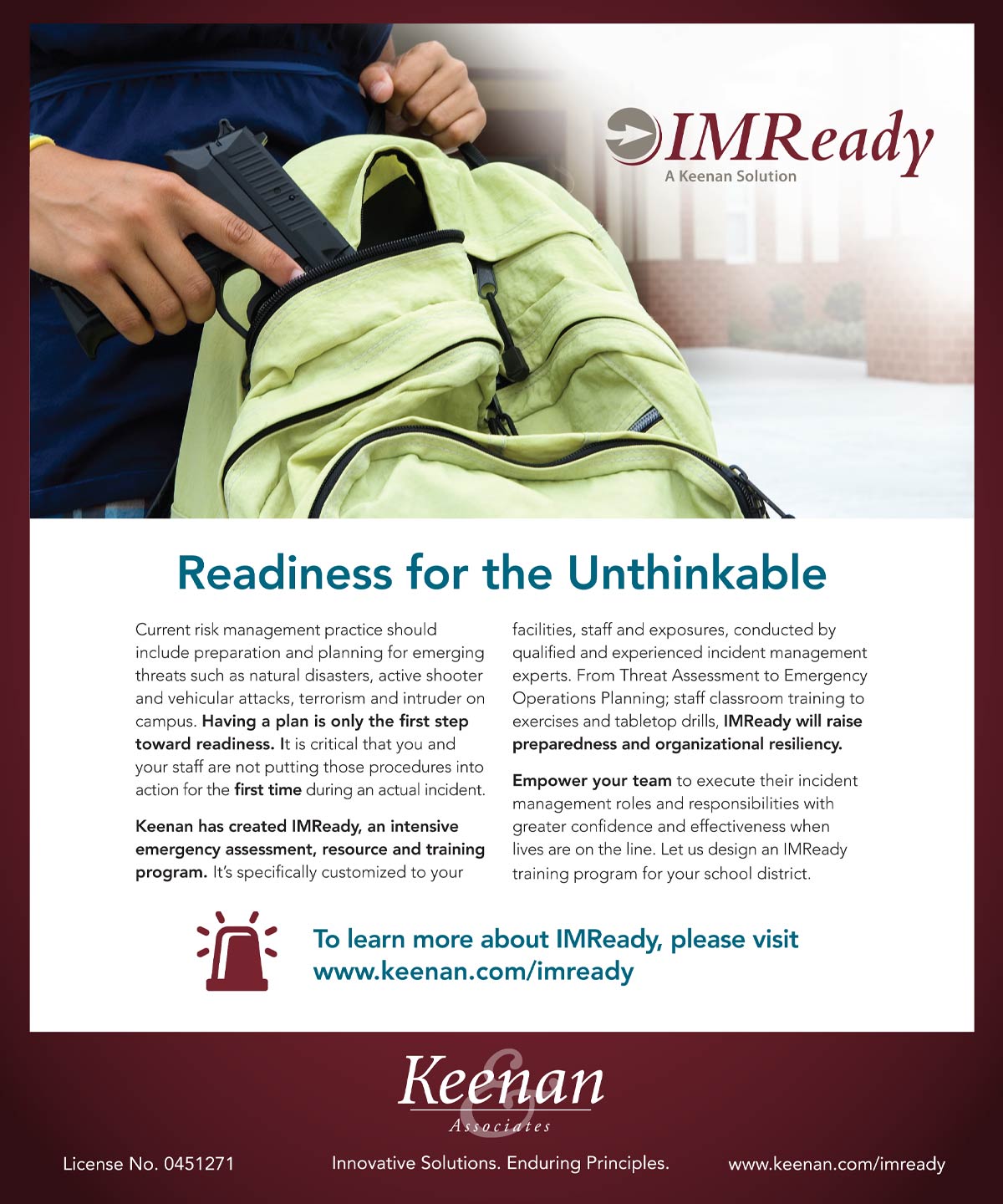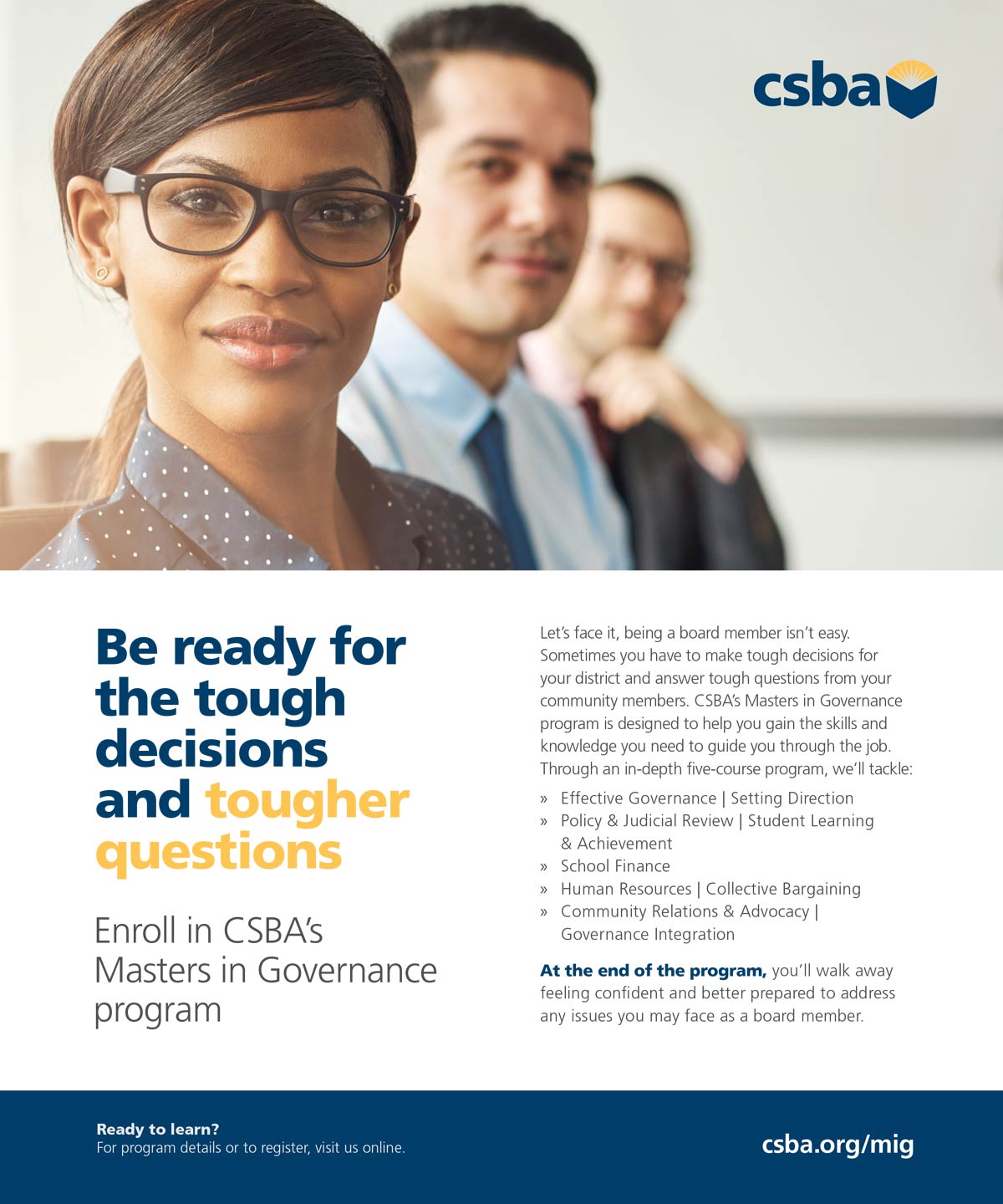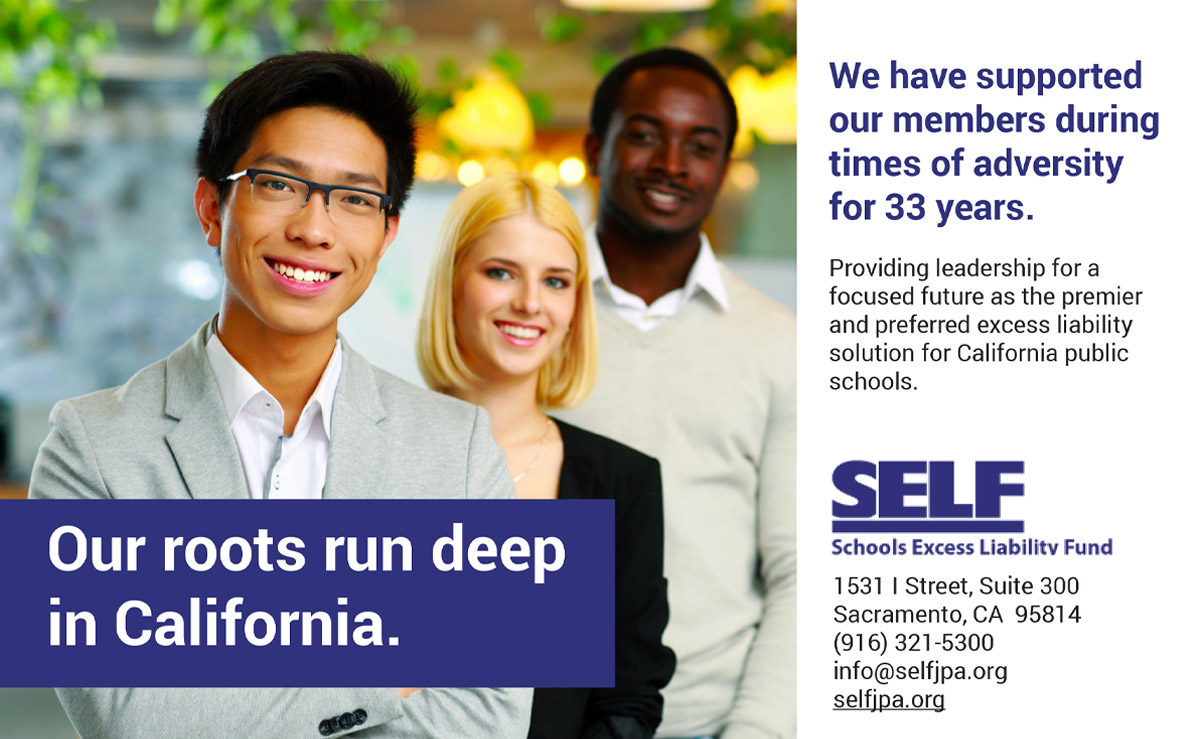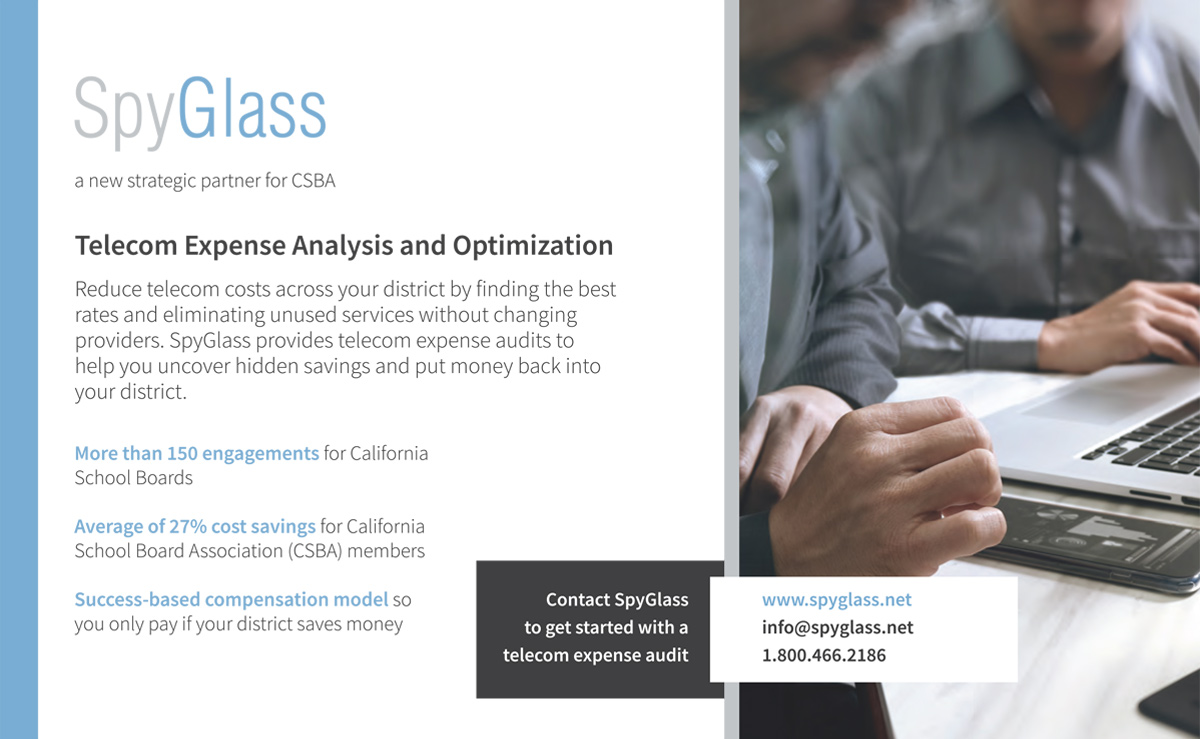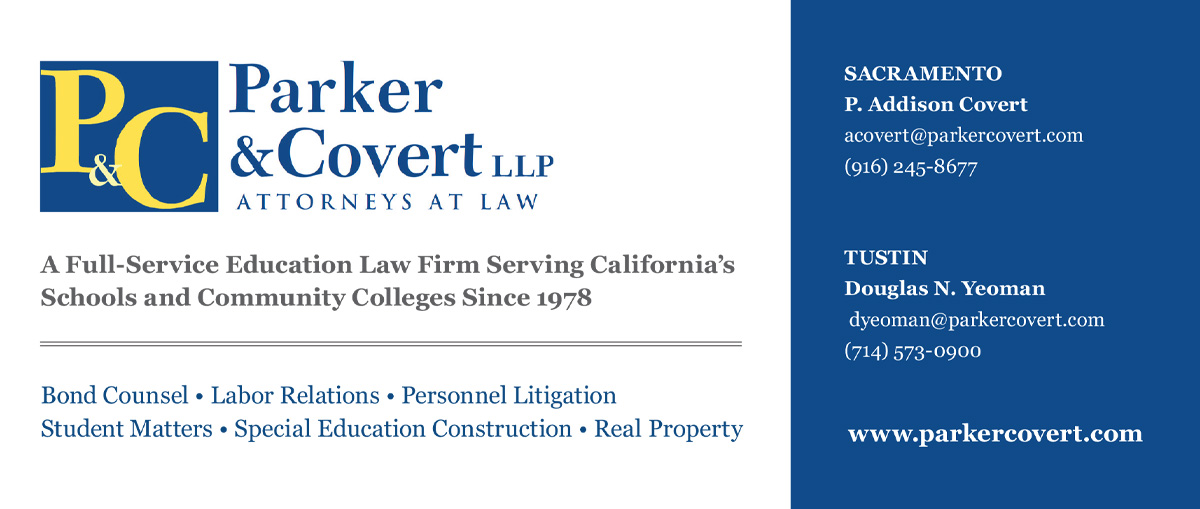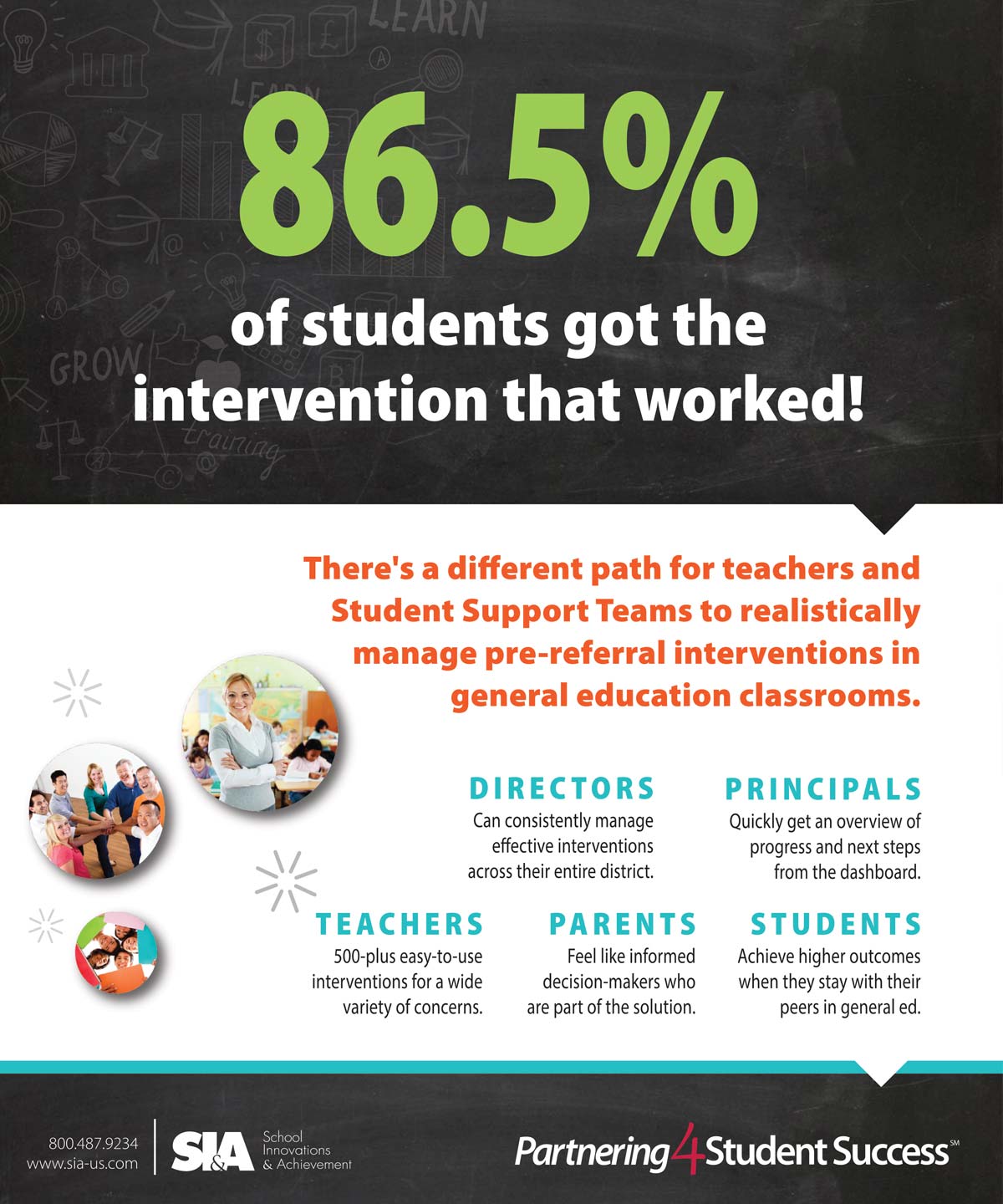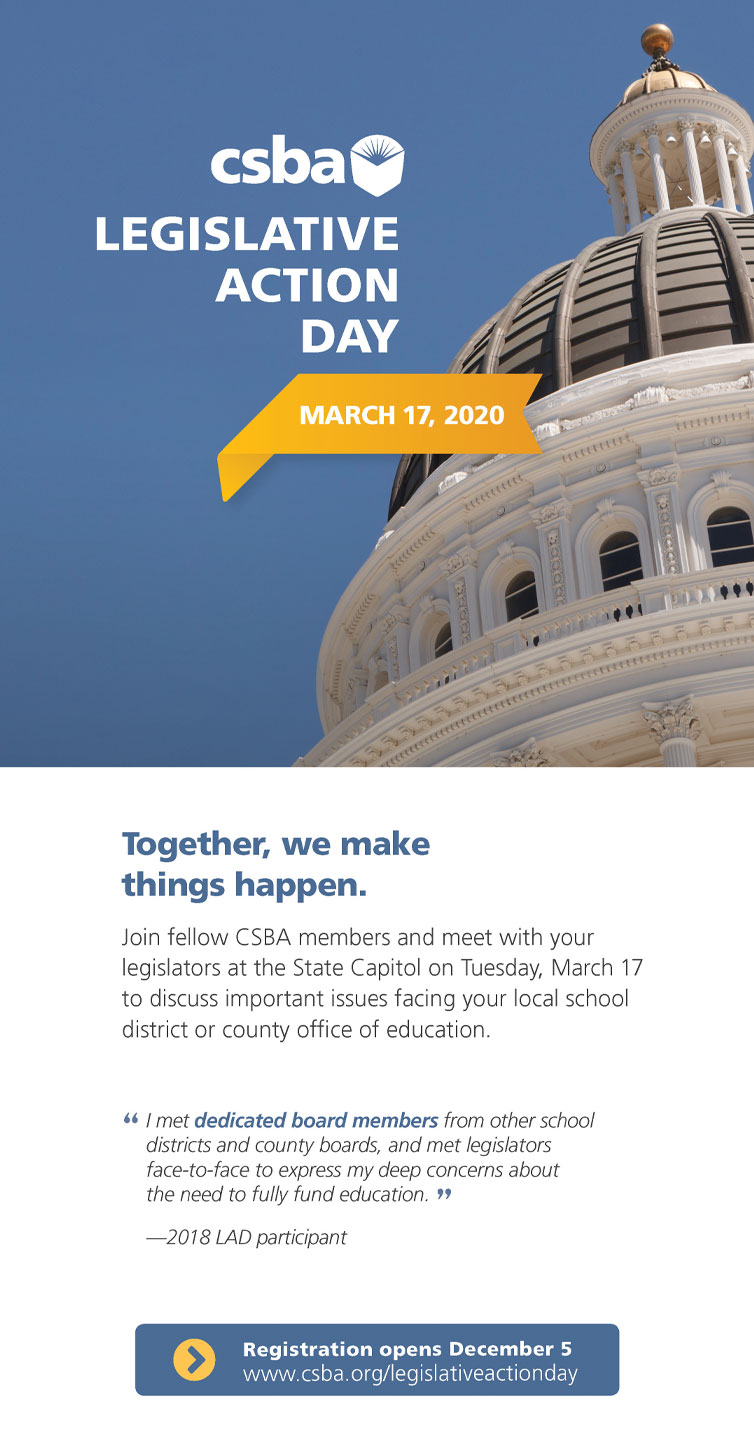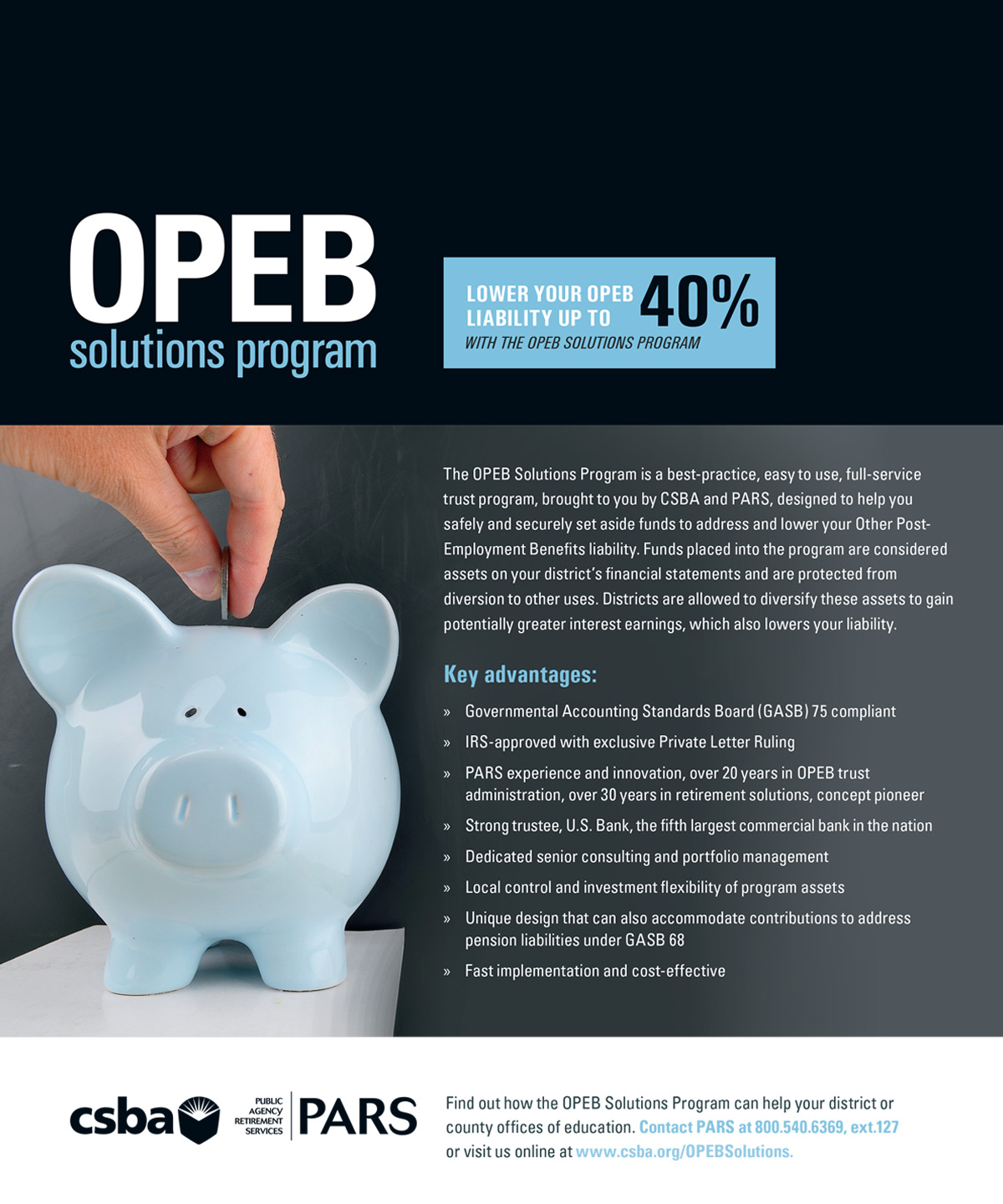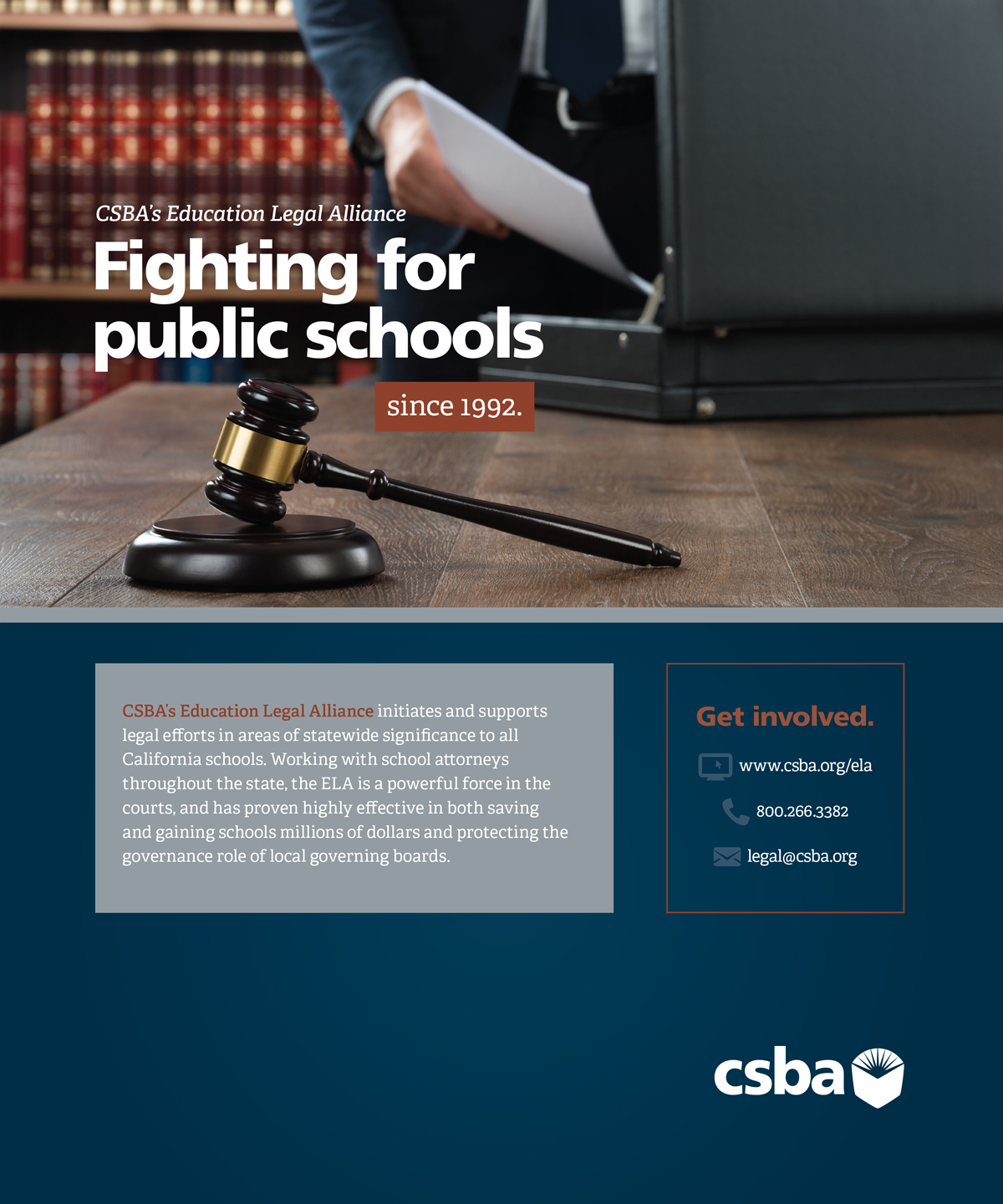
Fall 2019
by Vernon M. Billy
by Sepideh Yeoh, Teri Vigil and Arati Nagaraj
by Kathryn Meola
By David Miyashiro and Jean Eddy
By Mary Briggs and Manuel Buenrostro
Interview with Humberto Gurmilan
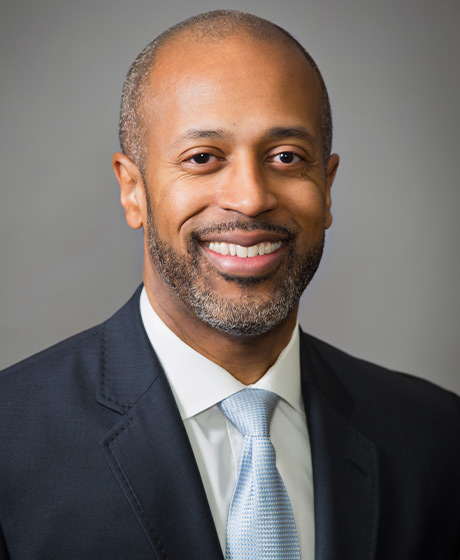
hile speaking about the release of his first state budget, Gov. Gavin Newsom said, “I know it’s rote and cliché to say it’s a reflection of our values, but it is a reflection of our values.”

Region 1, Del Norte County US
Sherry Crawford
Region 2, Siskiyou COE
A.C. “Tony” Ubalde, Jr.
Region 3, Vallejo City USD
Paige Stauss
Region 4, Roseville Joint Union HSD
Alisa MacAvoy
Region 5, Redwood City ESD
Darrel Woo
Region 6, Sacramento City USD
Yolanda Peña Mendrek
Region 7, Liberty Union HSD
Matthew Balzarini
Region 8, Lammersville Joint USD
Region 9, Atascadero USD
Susan Markarian
Region 10, Pacific Union ESD
Suzanne Kitchens
Region 11, Pleasant Valley SD
William Farris
Region 12, Sierra Sands USD
Meg Cutuli
Region 15, Los Alamitos USD
Karen Gray
Region 16, Silver Valley USD
Katie Dexter
Region 17, Lemon Grove SD
Wendy Jonathan
Region 18, Desert Sands USD
Region 20, Santa Clara USD
Kelly Gonez
Region 21, Los Angeles USD
Nancy Smith
Region 22, Palmdale SD
Helen Hall
Region 23, Walnut Valley USD
Donald E. LaPlante
Region 24, Downey USD
Crystal Martinez-Alire
Director-at-Large American Indian,
Elk Grove USD
Gino Kwok
Director-at-Large Asian/Pacific Islander,
Hacienda La Puente USD
Director-at-Large African American,
Monterey Peninsula USD
Heidi Weiland
Director-at-Large County, El Dorado COE
Joaquín Rivera
Director-at-Large Hispanic, Alameda COE
Dana Dean
CCBE President, Solano COE
Chris Ungar
NSBA Director, San Luis Coastal USD
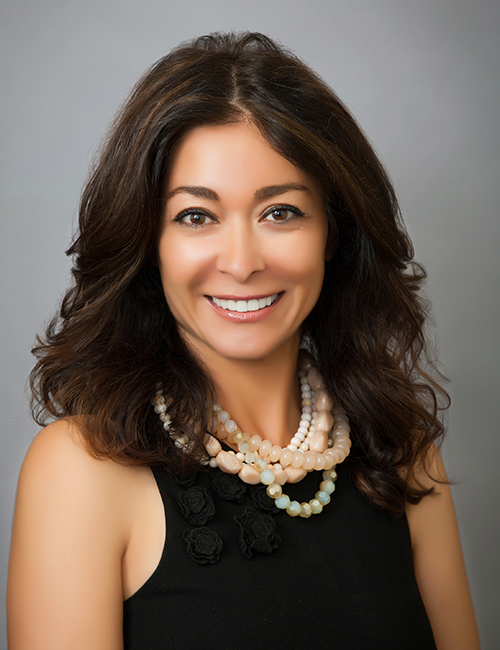
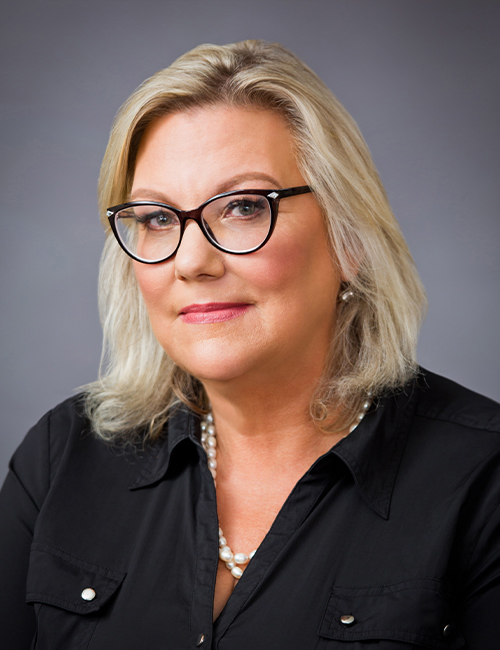
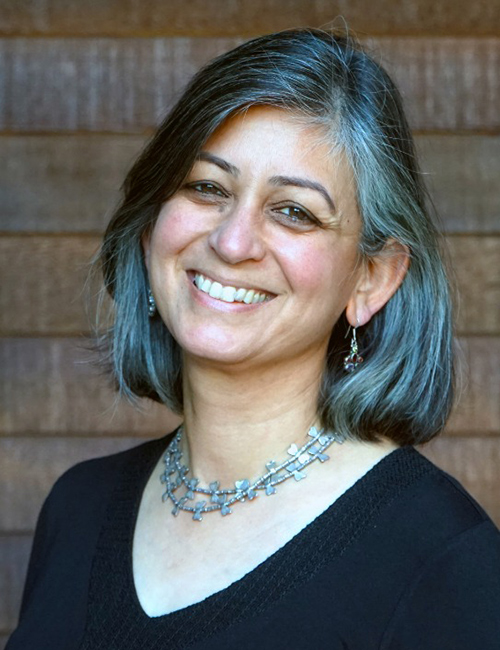
This year, in addition to our column regulars Deb Dudley, Steve Ladd, Arati Nagaraj, Luan Burman Rivera and Sepideh Yeoh, we are welcoming new consultants to the column. This issue introduces Teri Vigil, a board member for the Fall River Joint Unified School District since 2000. She is a Governance Consultant with CSBA’s Governance Consulting Services, creating customized board development workshops for governance teams.
BoardWise is a forum for board members and superintendents across the state to share questions about governance and board-superintendent relations. Send your questions to boardwise@csba.org.
Dear BoardWise,
In building and maintaining a supportive governance structure, what are some practices to provide opportunities for board members who are transitioning off the board, and yet would like to maintain some level of involvement and continue to contribute?

Troy Flint, tflint@csba.org
Managing Editor
Kimberly Sellery, ksellery@csba.org
Marketing Director
Serina Pruitt, spruitt@csba.org
Staff Writers and Contributors
Andrew Cummins, acummins@csba.org
Aaron Davis, adavis@csba.org
Alisha Kirby, akirby@csba.org
Graphic Design Manager
Kerry Macklin, kmacklin@csba.org
Senior Graphic Designer
Mauricio Miranda, mmiranda@csba.org
Circulation and Advertising
csba@csba.org
Emma Turner, La Mesa-Spring Valley SD
President-elect
Xilonin Cruz-Gonzalez, Azusa USD
Vice President
Tamara Otero, Cajon Valley Union SD
Immediate Past President
Mike Walsh, Butte COE
CEO & Executive Director
Vernon M. Billy
Articles submitted to California Schools are edited for style, content and space prior to publication. Views expressed are those of the authors and do not necessarily represent CSBA policies or positions. Articles may not be reproduced without written permission of the publisher. Endorsement by CSBA of products and services advertised in California Schools is not implied or expressed.

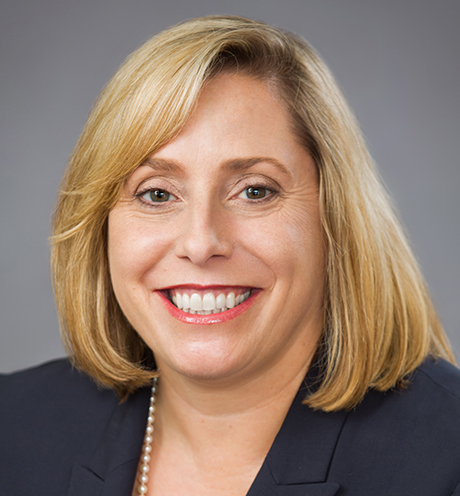
chool boards are corporate bodies created for the purpose of implementing state legislative policy and locally administering the state’s system of public education. School boards may only act as a “whole,” or by majority rule, unless a duty or responsibility has been delegated or assigned to individual board members or a committee of the board. No individual board member has authority to bind the school district independent of the decisions of a majority of the board.
One power and duty of a school board is to hire legal counsel. California Education Code §§ 35041.5, 35204, and 35205 authorize the governing board to hire an attorney as a district employee or independent contractor or to contract with a law firm to provide legal services for purposes deemed appropriate by the board. Education Code § 35041.5 specifies that a county board of education and the superintendent of schools of the same county are required to appoint the same legal counsel to provide unrestricted, independent advice to the board. (86 Ops.Cal.Atty.Gen. 57 (2003).) Notwithstanding this specific requirement for county boards of education and county superintendents, school districts and county offices of education engage legal counsel from a variety of sources, including employing an internal general counsel, contracting with one or more private law firms, or contracting with a government agency, such as a county counsel or joint powers authority. According to the Rules of Professional Conduct of the State Bar of California, when an attorney is hired by an organization such as a school district, the attorney’s client is the district as a whole, and not any individual board member or employee. (California Rules of Professional Conduct, Rule 1.13.)
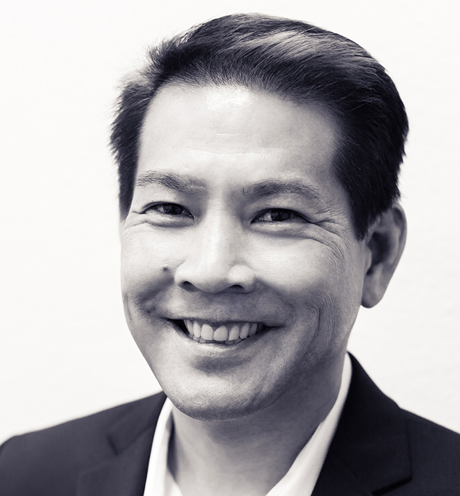
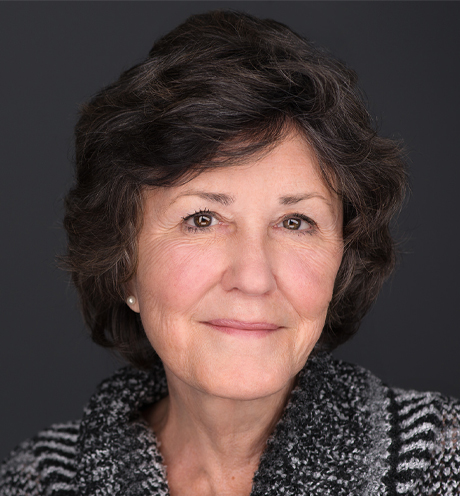
n the Cajon Valley Union School District — a wonderfully diverse school district that serves a socioeconomic population with nearly two-thirds of families living in or nearly in poverty — high-skill, high-wage jobs in the community often go unfilled. Across the nation, school districts are experiencing a similar landscape. It’s a troubling pattern raising some tough questions for schools about what they can do to help shift this alarming trend.
A clear path and supportive resources can help all kids become productive members of society and participants in the economy. In order for children to thrive as people and eventual leaders in their communities, they must have the knowledge and skills to exercise agency as they grow to adulthood. Their success in life should include a range of measures including career, personal fulfillment, good mental and physical health, and a feeling of belonging in their communities. If kids know themselves, know their options and can make informed choices, they will be well-positioned to pursue and achieve their dreams, wherever they may lead.
class act: Best practices in action
class act:
Best practices in action
class act:
Best practices in action
hat started as a conversation between two high school teachers has turned into a buzzworthy model of cross-curricular collaboration in the heart of California’s Central Valley.
Inside Manteca Unified School District’s Sierra High School, science teacher Steve Unterholzner can be found instructing STEM activities not only in his classroom, but in Matthew Tate’s special education classroom. The pair, agreeing that students in special education programs deserve the same opportunities as all students, started using a collaborative approach a couple of years ago.

chool districts must provide all students with the quality education and support they need to meet their potential and be ready for college, career and civic life. To help meet this challenge, education leaders should focus on the needs of students that have been historically underserved, including students with disabilities.
What does this mean for district governance teams? First, governance team members must understand the special education landscape. To help, CSBA released The Landscape of Special Education in California: A Primer for Board Members in May 2019 and continues to advocate for increased resources through its Full and Fair Funding initiative. Learning about best practices can help trustees and superintendents ask informed questions about local programs and support investments that are shown to improve outcomes for students with disabilities. With accurate information in hand, governance teams can make decisions to ensure equity, transparency and accountability in the education provided to all students.
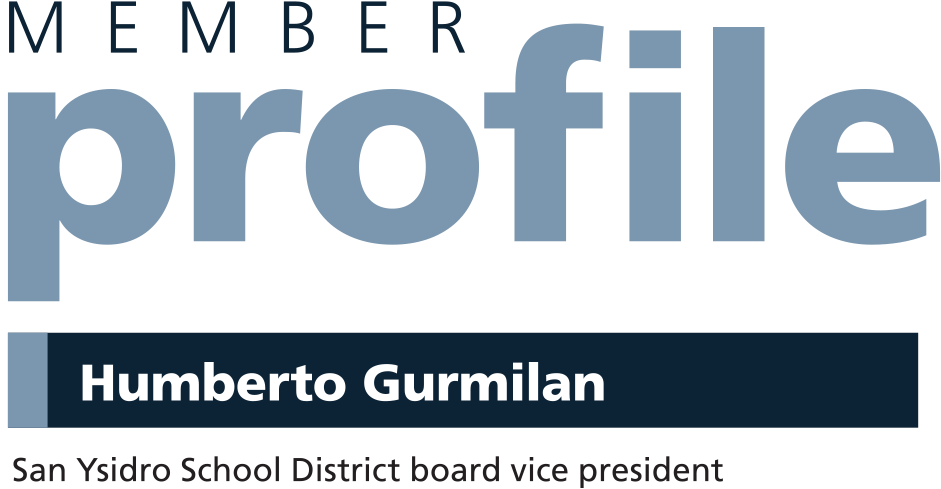
How long have you been a school board member and what inspired you to become one?
I was elected to the San Ysidro School District board in November of 2018 and it has been an overwhelmingly gratifying experience. I was inspired to run for a seat on the board because I felt a need to serve the students and families of my community. I was not comfortable with the way things were going in our district.
What was it like to go tandem skydiving this April with a member of the U.S. Army Golden Knights?
It was one of the most amazing experiences in my life. It was an honor to take the leap with such an outstanding and well-prepared group in our military — and the experience as a whole was amazing. The sensation and view of falling from 12,000 feet over San Diego was incredible and something I will never forget. If they call me again, I would not hesitate to jump one more time.
What do you see as the role of public education?
The most important role and responsibility that those of us in public education have is to ensure that all students have the fair opportunity and safe environment to become active and successful participants in society.
Who was one of your favorite teachers and why?
I have been fortunate to have plenty of great teachers in my life, but two that were equally important and were there when I returned to school after my injury were Trish Rodgers and Kathleen Obrist, both retired from Montgomery High School. They both inspired me, set very high standards for me and always pushed me to become a better student and person. I owe a lot to them for the role they played in a very crucial moment in my life.
How have you turned the surfing accident that paralyzed you at age 15 into a passion for serving young people with disabilities?
I’ve always seen myself as a prime example of someone who achieved his dreams because of opportunities I was fortunate to have. Along with the support from my family and the community, I was able to turn a tragic injury and disability into possibilities. I want to help create these opportunities for others, which is another reason I am on the San Ysidro school board. In 2015, I founded the Gurmilan Foundation, a nonprofit organization, to help empower individuals with disabilities so they can reach their full potential.
How would you reflect on your experience at the May 22 Rally for Education at the State Capitol?
It was great to see so many dedicated professionals and students pushing for Fair and Full Funding in our state. I was inspired to see that we’re coming together as one and we’re willing to change the status quo. It’s proof that if each of us continues to work for our students, in time California will be the best or near the top in the country in education.
What advice do you have for new or aspiring school board members?
I would say go for it! If you feel a desire to serve the students in your community, go for it! Don’t hesitate or doubt yourself. If you’re truly passionate about education, you will do great. Immerse yourself in the role, learn and prepare yourself as much as possible. But overall, keep students as the focus because they are the reason you’re serving or running.

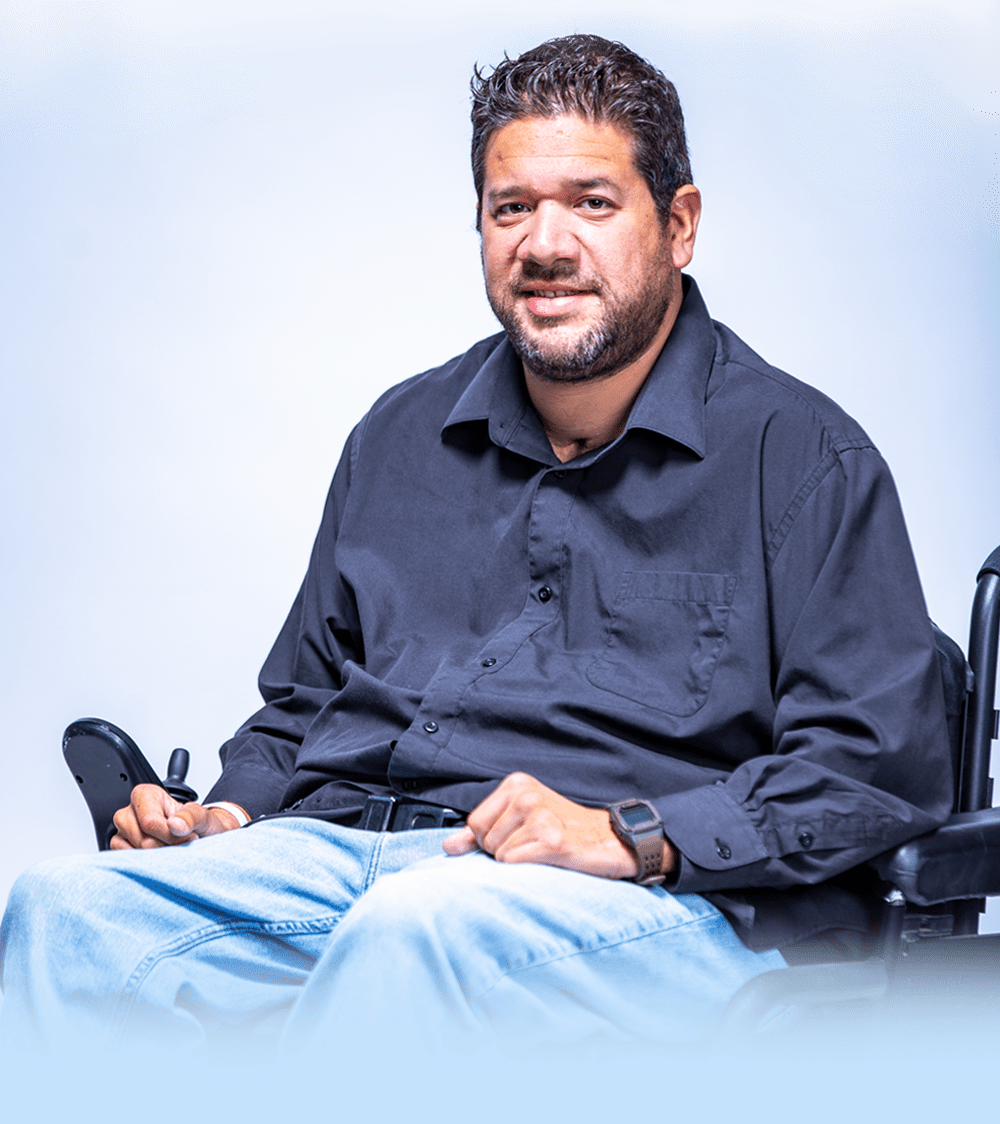
How long have you been a school board member and what inspired you to become one?
I was elected to the San Ysidro School District board in November of 2018 and it has been an overwhelmingly gratifying experience. I was inspired to run for a seat on the board because I felt a need to serve the students and families of my community. I was not comfortable with the way things were going in our district.
What was it like to go tandem skydiving this April with a member of the U.S. Army Golden Knights?
It was one of the most amazing experiences in my life. It was an honor to take the leap with such an outstanding and well-prepared group in our military — and the experience as a whole was amazing. The sensation and view of falling from 12,000 feet over San Diego was incredible and something I will never forget. If they call me again, I would not hesitate to jump one more time.
What do you see as the role of public education?
The most important role and responsibility that those of us in public education have is to ensure that all students have the fair opportunity and safe environment to become active and successful participants in society.
Who was one of your favorite teachers and why?
I have been fortunate to have plenty of great teachers in my life, but two that were equally important and were there when I returned to school after my injury were Trish Rodgers and Kathleen Obrist, both retired from Montgomery High School. They both inspired me, set very high standards for me and always pushed me to become a better student and person. I owe a lot to them for the role they played in a very crucial moment in my life.
How have you turned the surfing accident that paralyzed you at age 15 into a passion for serving young people with disabilities?
I’ve always seen myself as a prime example of someone who achieved his dreams because of opportunities I was fortunate to have. Along with the support from my family and the community, I was able to turn a tragic injury and disability into possibilities. I want to help create these opportunities for others, which is another reason I am on the San Ysidro school board. In 2015, I founded the Gurmilan Foundation, a nonprofit organization, to help empower individuals with disabilities so they can reach their full potential.
How would you reflect on your experience at the May 22 Rally for Education at the State Capitol?
It was great to see so many dedicated professionals and students pushing for Fair and Full Funding in our state. I was inspired to see that we’re coming together as one and we’re willing to change the status quo. It’s proof that if each of us continues to work for our students, in time California will be the best or near the top in the country in education.
What advice do you have for new or aspiring school board members?
I would say go for it! If you feel a desire to serve the students in your community, go for it! Don’t hesitate or doubt yourself. If you’re truly passionate about education, you will do great. Immerse yourself in the role, learn and prepare yourself as much as possible. But overall, keep students as the focus because they are the reason you’re serving or running.
of The
Teacher
Strike
of The
Teacher
Strike

California is at a critical juncture in using new curriculum and funding distribution to close achievement gaps, improve graduation rates and prepare all students for success after high school.

Two important changes in the last five years are the implementation of the Common Core State Standards in English language arts and math, and funding distribution through the Local Control Funding Formula. The standards are more rigorous and emphasize the critical-thinking and problem-solving skills needed for success in a global economy, while flexibility granted by the LCFF allows districts to use targeted funds where they are most needed.

California is at a critical juncture in using new curriculum and funding distribution to close achievement gaps, improve graduation rates and prepare all students for success after high school.

Two important changes in the last five years are the implementation of the Common Core State Standards in English language arts and math, and funding distribution through the Local Control Funding Formula. The standards are more rigorous and emphasize the critical-thinking and problem-solving skills needed for success in a global economy, while flexibility granted by the LCFF allows districts to use targeted funds where they are most needed.

Two important changes in the last five years are the implementation of the Common Core State Standards in English language arts and math, and funding distribution through the Local Control Funding Formula. The standards are more rigorous and emphasize the critical-thinking and problem-solving skills needed for success in a global economy, while flexibility granted by the LCFF allows districts to use targeted funds where they are most needed.
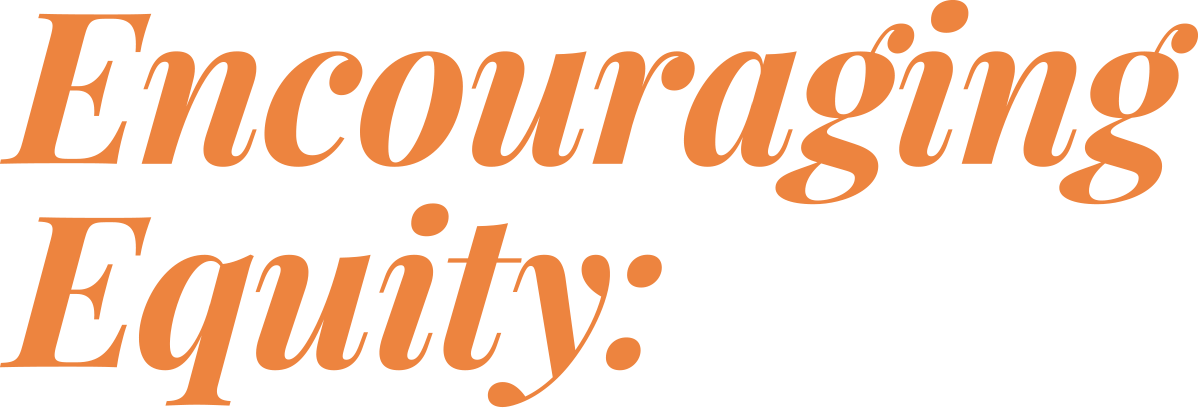

But to move equity and history forward both at their districts and on a larger scale, board members first had to look inward. What followed in that room were deep conversations, powerful moments of self-reflection and a realization that one’s own biases and prejudices must be acknowledged before focusing on structural educational inequities.



But to move equity and history forward both at their districts and on a larger scale, board members first had to look inward. What followed in that room were deep conversations, powerful moments of self-reflection and a realization that one’s own biases and prejudices must be acknowledged before focusing on structural educational inequities.

ruce Baker is a professor in the Graduate School of Education at Rutgers in New Jersey and is widely recognized as a leading scholar in the field of education finance. Serving in both academic and professional capacities, he has authored a multitude of peer-reviewed journal articles, policy briefs, editorials, books and reports on topics including state school finance policy, teacher and administrator labor markets and preparation pipelines, charter school funding, and higher education finance and policy.
His recent work has focused on measuring cost variations associated with schooling contexts and student population characteristics, including ways to better design state school finance policies and local district allocation formulas for better meeting the needs of students.
My areas of study include state school finance systems, the financing of public, charter and private schools, and how school funding intersects with such things as teacher labor markets, and ultimately, student outcomes.
Kelly Jensen
Ken Pfalzgra
Lawrence King
Michael Fox
Tim Jorgensen
Antelope Valley Union HSD
Amanda Parrell
Giovanna Perez‐Saab
East Side Union HSD
Pattie Cortese
Emery USD
Brynnda Collins
Quiauna Scott
Nancy Schuler‐Jones
Steve Straight
Los Altos ESD
Bryan Johnson
Vaishali Sirkay
Los Gatos Union ESD
John Kuntzmann
Peter Noymer
Jorge Pacheco
Oak Run ESD
Sue Cooper
Ocean View SD
Patricia Singer
Diana Perez
Santa Paula USD
Jeri Mead
Saugus Union SD
Julie Olsen
Colleen Hawkins
Kelly Jensen
Ken Pfalzgra
Lawrence King
Michael Fox
Tim Jorgensen
Antelope Valley Union HSD
Amanda Parrell
Arcata ESD
Carrie Kelly
Joseph McKinzie
Luke Biesecker
Prairie Moore
Banning USD
Jason Smith
Richard Lopez
Middletown USD
Misha Grothe
Milpitas USD
Kelly Chuan
Michael Tsai
Monterey COE
Deneen Guss
Moorpark USD
Scott Dettorre
Moreno Valley USD
Claudia Jauregui
Marsha Sue Locke

